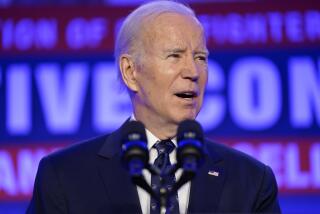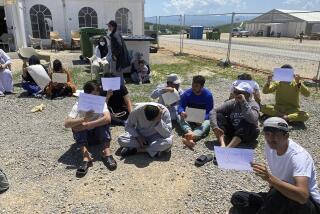U.S. may expand use of its prison in Afghanistan
- Share via
Reporting from Washington — The White House is considering whether to detain international terrorism suspects at a U.S. military base in Afghanistan, senior U.S. officials said, an option that would lead to another prison with the same purpose as Guantanamo Bay, which it has promised to close.
The idea, which would require approval by President Obama, already has drawn resistance from within the government. Army Gen. Stanley A. McCrystal, the top commander of U.S. and NATO forces in Afghanistan, and other senior officials strongly oppose it, fearing that expansion of the U.S. detention facility at Bagram air base could make the job of stabilizing the country even tougher.
That the option of detaining suspects captured outside Afghanistan at Bagram is being contemplated reflects a recognition by the Obama administration that it has few other places to hold and interrogate foreign prisoners without giving them access to the U.S. court system, the officials said.
Without a location outside the United States for sending prisoners, the administration must resort to turning the suspects over to foreign governments, bringing them to the U.S. or even killing them.
In one case last year, U.S. special operations forces killed an Al Qaeda-linked suspect named Saleh Ali Saleh Nabhan in a helicopter attack in southern Somalia rather than trying to capture him, a U.S. official said. Officials had debated trying to take him alive but decided against doing so in part because of uncertainty over where to hold him, the official added.
U.S. officials find such options unappealing for handling suspects they want to question but lack the evidence to prosecute. For such suspects, a facility such as Bagram, north of Kabul, remains necessary, officials said, even as they acknowledged that having it in Afghanistan could complicate McCrystal’s mission.
“No one particularly likes any of the choices before us right now, but Bagram may be the least bad among them,” a senior Defense official said.
With such a move certain to draw furious criticism by allies and human rights groups that the administration was re-creating the U.S. military prison at Guantanamo Bay, Cuba, officials stressed that no final decisions have been made, and a White House spokesman declined to comment.
The idea of using Bagram emerged as the White House National Security Council solicited suggestions on how to handle detainees from the Justice Department, CIA and other government agencies.
The procedures for holding suspected terrorists have been largely in limbo as the White House sought to carry out Obama’s pledge last year to close the Guantanamo prison and overhaul the U.S. detention process.
Although it has been known for some time that the administration was seeking options other than Guantanamo for holding existing prisoners, it has not been reported previously that it was considering Bagram for suspected terrorists that might be captured in the future.
Bagram remains controversial in Afghanistan because of documented cases of detainee abuse there, including two deaths, in the early months of the Afghan war. The original prison was recently replaced by a new detention facility on the U.S. base.
McCrystal fears that a decision to expand Bagram could be used by extremists for propaganda purposes, as Guantanamo has been. In addition to the abuse cases, the prison has been criticized for the interrogation techniques used there and the amount of time suspects have been detained without trial.
“Gen. McCrystal’s singular focus is on making sure our military campaign is successful,” the senior Defense official said. “Anything that potentially complicates that is something they are reluctant to embrace.”
There are about 800 prisoners at Bagram, but fewer than 10 are foreign fighters not captured in Afghanistan or in the Afghan-Pakistani border region, according to a Defense official.
No suspect captured elsewhere has been brought to Bagram during the Obama administration. Similarly, no additional prisoners have been sent to Guantanamo.
U.S. officials emphasized that the number of additional prisoners at Bagram would be modest. If Osama bin Laden or other senior Al Qaeda leaders were captured, they probably would be sent to the U.S. for prosecution. Bagram, by contrast, would hold lesser-known suspects, whom the U.S. government may not be able to prosecute but who would be deemed to remain a threat if released, the officials said.
The debate over detainees intensified in recent weeks after the military command in Afghanistan announced plans to turn the Bagram facility over to the Afghan government. That step surprised officials in Washington who want to preserve the option of using the prison to hold terrorism suspects.
McCrystal said last week that the prison would be handed over to the Afghans in January. It is unlikely the U.S. would send terrorism suspects to Bagram once it is under the control of the Afghan government. As a result, some officials in Washington want to slow down the hand-over, at least until other options are examined.
The Obama administration is hoping to buy a state prison in Thomson, Ill., to turn it into a federal facility to house some terrorism suspects. But the administration has indicated that any such suspects held at the prison would be limited to detainees facing prosecution and those currently at Guantanamo.
Thomson is not viewed as an option for suspected terrorists captured outside the U.S. because of near-certain resistance from Congress and the public. “Thomson is there to clean up a mistake, not to serve as a permanent model for future detentions,” said Tom Malinowski, the Washington advocacy director of Human Rights Watch.
In addition, any suspected terrorist held inside the U.S. would probably have the right to challenge his detention in federal courts. Bagram, for now, is outside the reach of U.S. courts.
In April 2009, U.S. District Judge John D. Bates ruled that detainees captured outside Afghanistan and shipped to Bagram could seek court review of their detention, like prisoners at Guantanamo Bay. Bates’ ruling allowed the detainees to file habeas corpus petitions seeking their freedom.
Bates put his ruling on hold after the administration filed an appeal, to the chagrin of human rights groups who said it conflicted with Obama’s pledge to overhaul George W. Bush-era detention policies. If the original ruling is upheld, it would undermine a key legal justification for using Bagram.
Another uncertainty, officials said, is that it’s not known whether Afghan President Hamid Karzai would continue to accept having non-Afghan prisoners at Bagram.
The prison that opened this year replaced the Soviet-era hangar that had been used since 2002 to house prisoners, sometimes under harsh conditions.
An official familiar with discussions over Bagram said McCrystal supports using the prison for militants picked up in Pakistan who have a “direct impact on the fight in Afghanistan.” That would include Mullah Abdul Ghani Baradar, the Taliban leader captured in Pakistan in February, the official said.
Baradar’s capture renewed a debate over where to put high-level detainees. But as an Afghan Taliban leader captured in Pakistan, Baradar does not pose as many legal and political complications for U.S. officials as extremists seized in Yemen, Somalia or elsewhere.
When the issue came up at a Senate hearing last week, officials ducked the question. Navy Adm. Eric T. Olson, head of U.S. Special Operations Command, was asked where the U.S. would send a suspect captured in Yemen.
“That’s a question that, on so many levels, we would have to go into closed session” to answer, Olson replied.











